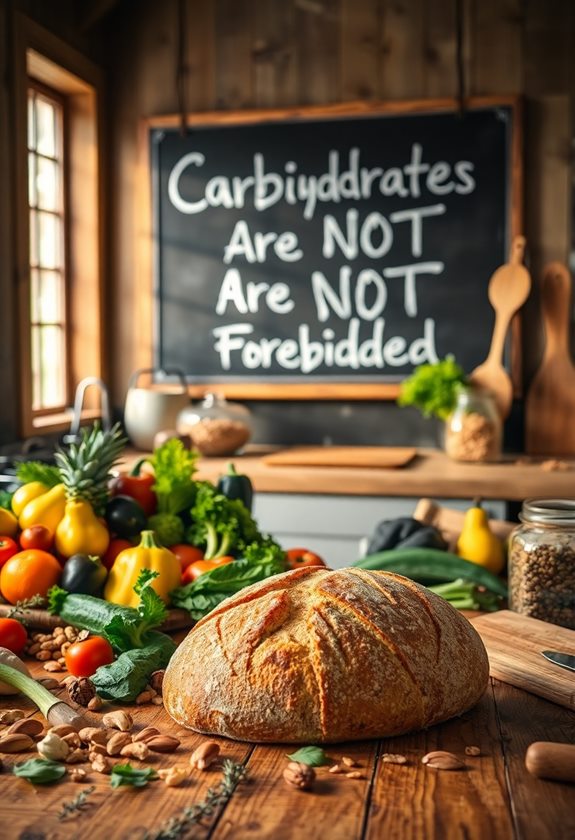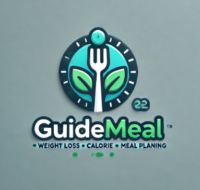Think the Paleo diet is just about meat? That's one of the biggest myths! In reality, it includes a rich mix of fruits, vegetables, nuts, and seeds. You can create colorful, hearty meals that are both satisfying and nutritious. What about carbs? It's not about avoiding them completely—whole foods like sweet potatoes are great! While some may worry about costs, meal planning can make it manageable. And listen to your body regarding dairy; it's okay to skip it if you don't tolerate it well. Curious about more myths and facts? There's so much to discover! 🌟
Key Takeaways
- The Paleo diet includes a variety of foods, such as fruits, vegetables, nuts, and seeds, not just meat.
- Dairy can be part of the Paleo diet for some individuals, but it's not essential for everyone.
- Acceptable carbohydrates in the Paleo diet include fruits, vegetables, and nuts, while refined carbs should be avoided.
- A well-balanced Paleo diet requires careful planning to ensure all essential nutrients are consumed, avoiding dietary imbalances.
- Regular exercise is crucial to enhance the benefits of the Paleo diet, promoting overall health and well-being.
The Meat-Only Myth

When you hear "Paleo diet," you might picture a plate piled high with steak, but that's a misleading stereotype. Sure, meat is a big part of the Paleo lifestyle, but it's far from the only food on the menu! In fact, incorporating a variety of ingredients can lead to flavorful and nutrient-dense meals, much like those found in 30-minute plant-based recipes. Have you ever considered how fruits, veggies, nuts, and seeds fit into this plan?
A balanced Paleo plate looks colorful and diverse. Think about roasted veggies alongside grilled chicken or a crunchy salad topped with avocado. This mix not only keeps meals exciting but also guarantees you're getting essential nutrients. You don't want to miss out on fiber from fruits and veggies, right?
Many people worry that going Paleo means they'll feel deprived. But, guess what? You can enjoy delicious meals without feeling hungry. You might even find new favorite recipes! For example, have you tried a hearty vegetable soup with chunks of tender meat? It's satisfying and nourishing.
Dairy Dilemmas
Many people worry that dairy can cause health issues, like bloating or skin problems. But not everyone reacts the same way. Have you ever noticed how some people thrive on yogurt or cheese, while others avoid it like the plague? It really comes down to your body. Choosing the right meal prep containers can also play a role in maintaining a balanced diet, as material safety and durability can help you store your dairy products properly.
If you love dairy and it doesn't upset your stomach, you might choose to include it. Grass-fed options, like yogurt or cheese, are often seen as healthier because they're closer to what our ancestors might have eaten. Plus, they can add variety to your meals!
However, if dairy doesn't agree with you, that's perfectly fine too. You can still enjoy a balanced Paleo diet with plenty of other delicious foods. 🌿
In the end, it's about finding what works for you. So, whether you're a dairy lover or not, listen to your body and make choices that feel good! What do you think?
Carbohydrates Are Forbidden

Carbohydrates often get a bad rap in the Paleo community, but they're not entirely forbidden. In fact, you can enjoy certain carbs that fit into the Paleo framework. Think about it: our ancestors ate fruits, vegetables, and nuts. These foods are packed with nutrients and provide the energy you need! Incorporating foods like organic green beans into your diet can be a fantastic way to enjoy healthy carbohydrates that are rich in vitamins and low in calories.
Instead of avoiding all carbs, focus on choosing the right ones. What do you think about swapping out processed grains for sweet potatoes or quinoa? These options are more in line with the Paleo diet and are still delicious. Plus, they offer vitamins and minerals that support your health.
You might wonder, "Are all carbs bad for me?" The answer is no! It's the refined carbs and sugars that can lead to health issues. By sticking to whole, unprocessed foods, you'll nourish your body while enjoying a variety of flavors.
Ultimately, it's all about balance. Embrace carbs from natural sources and listen to how your body reacts. You'll feel more energized and satisfied, and you won't miss out on the goodness that healthy carbs can bring! 🍠🥗 So, are you ready to rethink your carb choices?
Cost of the Paleo Diet
Eating healthy often comes with a price tag, and the Paleo diet is no exception. You might wonder, is it really worth the extra cost? While many people love the diet for its focus on whole foods, it can hit your wallet harder than other eating plans.
Here are three factors to evaluate when budgeting for the Paleo diet:
- Quality of Ingredients: You'll often buy organic fruits, veggies, and grass-fed meats. These options can be pricier than conventional products. Are you ready to invest in higher-quality foods?
- Specialty Items: Items like coconut flour, almond milk, and grass-fed butter can add up. Do you want to spend extra on these specialty ingredients, or can you find alternatives?
- Meal Prep: Cooking at home is a big part of the Paleo lifestyle, but it takes time and effort. Will you make the time to prepare your meals, or will eating out tempt you?
In the end, it's all about how you manage your budget. With some planning, you can enjoy a healthy Paleo diet without breaking the bank! 🍏🤩
Nutritional Imbalance Concerns

While the Paleo diet emphasizes whole, nutrient-dense foods, it can lead to potential nutritional imbalances if not carefully planned. Have you ever wondered if cutting out entire food groups might leave you missing some important nutrients? For example, when you skip grains and legumes, you might lose out on fiber and essential vitamins.
It's easy to focus on the meats, fruits, and vegetables, but you should think about balance. Not including dairy can mean you're missing calcium, which is vital for strong bones. Are you getting enough healthy fats? Nuts and seeds are great, but if you're not careful, you might end up with too much protein and not enough carbs or healthy fats.
To avoid these imbalances, consider tracking what you eat. A simple food diary can help you see if you're covering all your bases. You could also consult with a nutritionist to make sure you're on the right track. Remember, it's all about making the Paleo diet work for you without sacrificing your health! 🌟 So, are you ready to dive deeper into your food choices?
Exercise and Paleo Eating
When you embrace the Paleo diet, integrating exercise becomes essential to maximizing its benefits. Think about it: how can you truly thrive on clean, whole foods without moving your body? Exercise not only helps you maintain a healthy weight, but it also supports your overall well-being. So, what should you focus on?
- Strength Training: Building muscle enhances your metabolism and keeps your bones strong. Try bodyweight exercises like push-ups or squats to start.
- Cardio Activities: Engaging in activities like running, cycling, or swimming boosts your heart health and increases endurance. Even brisk walking can make a difference!
- Flexibility and Mobility: Don't forget about stretching and yoga. These practices help prevent injuries and improve your range of motion.
Incorporating these types of exercise into your routine will help you feel more energized and balanced. It's not just about what you eat; it's about how you move! So, why not give it a try? You might find that a little movement makes a big difference in your Paleo journey! 🌟

